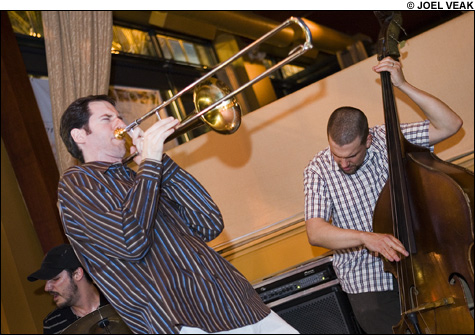
ALL FOR ONE: The group sound — and the tunes — are what set Gypsy Schaeffer apart. |
WFNX Jazz Brunch Top Five
1. Abbey Lincoln, Abbey Sings Abbey [Verve]
2. Papa Grows Funk, Mr. Patterson’s Hat [Funky Krewe Records]
3. Sam Yahel, Truth and Beauty [Origin]
4. Spanish Harlem Orchestra, United We Swing [Six Degrees]
5. Michael Brecker, Pilgrimage [Heads Up] |
Throughout my notes on the Boston quartet Gypsy Schaeffer, I’ve written “great tune.” That’s one important thing for you to know. The other is that Gypsy Schaeffer are a band. In jazz, neither of these is something to take for granted.You’d think a virtuoso music like jazz would be built on great tunes, but really it’s built on great players — and on the great tunes that only a handful of them wrote. There’s the book of standards, and then there’s Ellington, Monk, Mingus, Ornette. And who else? Not Miles, particularly — he was more of an arranger, collaborator, bandleader, and studio auteur. Even the mighty Wynton — despite the epic reach of his writing — hasn’t given us much in the way of great tunes. But Gypsy Schaeffer have a knack for memorable forays on the short form.
Take saxophonist Andy Voelker’s “What’s the Deal?”, the opening piece from the band’s homonymous 2003 debut. It blasts out of the gate with an aggressive five-beat riff that repeats and modulates over a hard-walking medium up-tempo 4/4 before Voelker’s keening, Jackie McLean–like alto cry introduces a soaring secondary theme and turns into a stop-time figure at the bridge. It’s all tight and symmetrical, a classic question-and-answer arrangement of four-bar units, where what’s surprising is all the more so — and all the more satisfying — because it’s inevitable (“Of course!”).
Or take trombonist Joel Yennior’s “Lovesick Thoughts,” from that same debut album. Here’s a brooding ballad that deserves to be a classic. Again there’s the apposite call-and-response — long-toned opening phrases, blown in unison by Voelker and Yennior, before a beautiful, lyric B section. The broad harmonies that Yennior plays behind Voelker’s statement of the theme would make this a natural for the broad-canvas statement of a big band (and a good candidate for the Either/Orchestra, with whom Yennior has played since 1998).
Gypsy Schaeffer also have the peculiar appeal of the “pianoless” jazz ensemble. The absence of any chording instrument — a keyboard or a guitar — allows for maximum interplay between the two horns, more room for bass and drums, and no end of tantalizing harmonic ambiguity. This band capitalize on that set-up in their arrangements. Part of what makes “What’s the Deal?” work so well is the way Yennior and Voelker split off as they head into that bridge, Yennior playing low counterlines against Voelker’s melody.
“We try to interact as much as possible to fill up the space that you don’t have when you don’t have a piano player or guitar player,” Voelker says when I get together with the band at one of their regular haunts, the Fireplace Restaurant in Brookline. That continual use of counterpoint, the openness of the pianoless arrangements with plenty of collective improv, an inventive use of standard rhythms, and a general blues-based attitude all likewise recall Mingus, especially when they’re playing Yennior’s “Joisey Boys’ Shuffle” in the swaggering manner that recalls the great bassist’s “Boogie Stop Shuffle.”